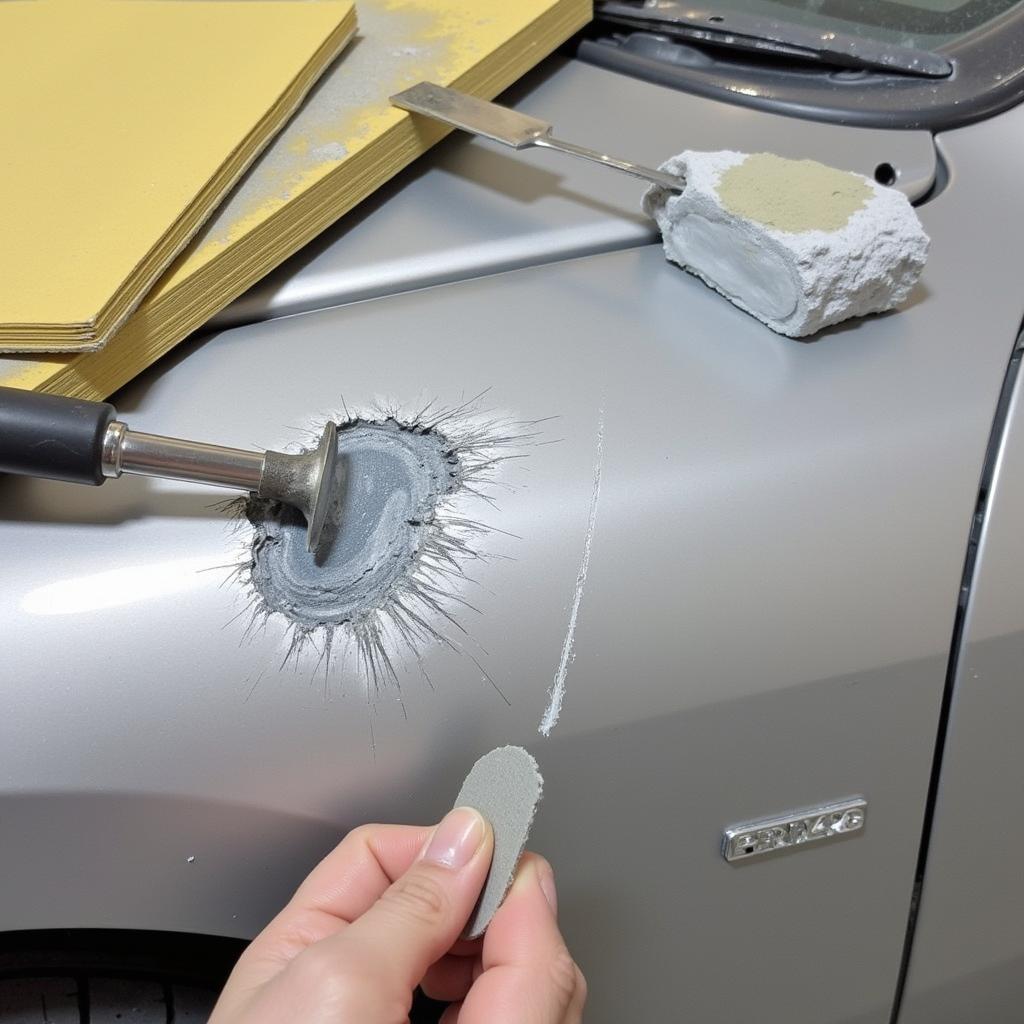Dealing with a scuffed up car body and paint is a frustrating experience. Whether it’s a minor scratch from a rogue shopping cart or a more significant scrape from a parking lot mishap, these blemishes can detract from your car’s appearance and even affect its resale value. This guide will walk you through everything you need to know about scuffed car body and paint repair, from assessing the damage to choosing the right repair method and preventing future scuffs.
Understanding the Different Types of Car Paint Damage
Before diving into repair options, it’s crucial to understand the nature of the damage. Scuffs and scratches vary in severity, and each type requires a specific approach.
Clear Coat Scratches
These are the most superficial type of damage, affecting only the clear coat – the protective layer on top of the paint. They often appear as light, hairline scratches and can sometimes be buffed out.
Paint Scratches
These scratches penetrate the clear coat and reach the colored paint layer. They’re more visible than clear coat scratches and require more involved repair methods.
Deep Scratches
These scratches go through the paint and expose the primer or even the bare metal underneath. Deep scratches require professional repair to prevent rust and further damage.
DIY Scuffed Car Body & Paint Repair Options
For minor scuffs and scratches, you might be able to tackle the repair yourself.
Using a Car Scratch Remover
Scratch removers are abrasive compounds that can buff out minor scratches. Apply a small amount to a microfiber cloth and gently rub the affected area in a circular motion.
Touch-Up Paint
For paint scratches, touch-up paint can be a cost-effective solution. Choose the correct color code for your car and apply the paint carefully using a fine-tipped brush.
Rubbing Compound
This is a more aggressive abrasive than scratch remover and can be used for slightly deeper scratches. However, use caution, as rubbing compound can remove too much paint if used incorrectly.
When to Seek Professional Help
For deep scratches, dents, or extensive damage, it’s best to consult a professional. Attempting DIY repairs on significant damage can often worsen the problem.
Benefits of Professional Repair
Professionals have the expertise and tools to properly assess and repair the damage. They can also ensure a perfect color match and a flawless finish.
Finding a Reputable Auto Body Shop
Look for shops with certifications, positive reviews, and a portfolio of their work. Don’t hesitate to ask for quotes from multiple shops before making a decision.
Preventing Future Scuffs and Scratches
Protecting your car’s paint is the best way to avoid costly repairs.
Regular Washing and Waxing
Washing removes dirt and grime that can scratch the paint, while waxing provides a protective layer.
Parking Strategically
Park away from shopping carts and other potential hazards. Consider parking further away from entrances in busy parking lots.
Protective Films and Coatings
Paint protection film (PPF) and ceramic coatings offer an extra layer of defense against scratches and other environmental factors.
Conclusion
Maintaining your car’s appearance requires addressing scuffed up car body and paint issues promptly. By understanding the types of damage, choosing the right repair method, and taking preventative measures, you can keep your car looking its best for years to come. Remember to always prioritize safety and consult a professional when needed.
FAQ
-
Can I use toothpaste to remove car scratches? While toothpaste can sometimes mask very superficial scratches, it’s not a recommended solution for car scratch repair.
-
How much does professional car scratch repair cost? The cost varies depending on the severity of the damage, the type of paint, and the location of the repair shop.
-
What is the best way to remove scratches from black cars? Black cars are particularly prone to showing scratches. Consult a professional for the best results.
-
Can I repair a deep scratch myself? While some minor deep scratches can be addressed with DIY methods, it’s generally recommended to seek professional help to prevent further damage and ensure a proper repair.
-
How long does touch-up paint take to dry? Touch-up paint typically dries within a few hours, but it’s best to refer to the manufacturer’s instructions.
-
What is the difference between rubbing compound and polishing compound? Rubbing compound is more abrasive and used for deeper scratches, while polishing compound is finer and used to restore shine.
-
Can I wax my car after repairing a scratch? Yes, you can wax your car after the repair area has fully cured.
Situations requiring questions.
- Noticeable scratch after a minor accident.
- Scratches appearing after a car wash.
- Deep scratches exposing the metal.
- Minor scratches that won’t buff out.
- Uncertainty about DIY repair versus professional repair.
Suggested further reading:
- Car Detailing Guide
- Understanding Car Paint Types
- Choosing the Right Car Wax
Need Assistance? Contact us!
For expert advice and assistance with your car repair needs, reach out to us via WhatsApp: +1(641)206-8880 or Email: [email protected]. Our 24/7 customer support team is ready to help.


